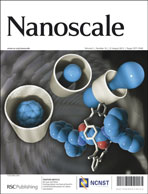Charge separation, protection of photocatalysts from hole attacks, and easy recyclability, which are of paramount importance in the development and applications of highly efficient and photochemically stable nanosized semiconductor photocatalysts, were achieved simultaneously by paramagnetic ZnFe2O4 nanocrystal decorated CdS nanorods. The photo-induced holes of CdS tend to migrate to the photochemically stable ZnFe2O4 domain while the photo-induced electrons of ZnFe2O4 tend to migrate to the photochemically more active CdS domain, achieving CdS protection and electron–hole separation. Decoration of ZnFe2O4 nanocrystals on CdS nanorod surfaces was achieved with a solvothermal process, giving a highly efficient, visible light responsive, photochemically stable, magnetically recyclable photocatalyst for hydrogen generation through water splitting. Specific hydrogen evolution rates as high as 2.44 mmol g−1 h−1 were achieved with the present product under visible light illumination, with its long term stability demonstrated.

You have access to this article
 Please wait while we load your content...
Something went wrong. Try again?
Please wait while we load your content...
Something went wrong. Try again?


 Please wait while we load your content...
Please wait while we load your content...